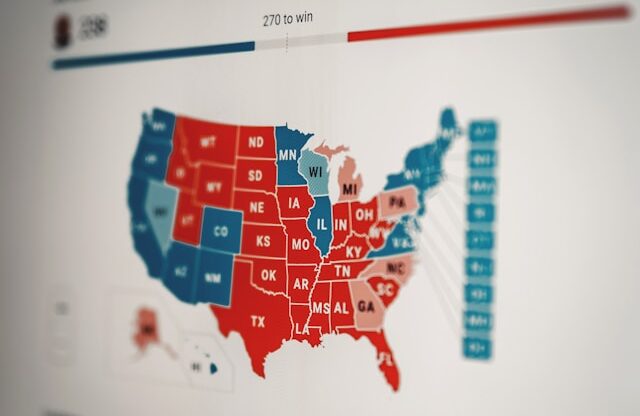Why are we so divided?
That’s a question I get asked often by Democrats and Republicans alike.
It’s ironic because it seems the only thing we can agree on is the division in our country and the significant problem it presents.
What was once a political culture with a healthy exchange of ideas looking to persuade the other side has devolved into a winner-take-all culture, where compromise is seen as a weakness, and the goal is not to persuade the other side but to dominate it.
This frustrates many of us and has turned our politics into a mess of rampant division and political spin.
It has also made the country less effective as the political parties seem more interested in political wins than doing what is best for the country.
You’re not alone if you feel exhausted from this division and the noise swirling around it.
However, there are ways to navigate this and return to a more practical and unified perspective toward politics.
In this article, we’ll discuss why the partisan divide in our country has become so bad and the solutions to navigating it, both of which come down to one concept: identity.

The Roots of Partisan Politics
Partisan politics is nothing new.
You’ll be hard-pressed not to find some sort of it in a democratic nation, as democracies embrace multiparty systems and different perspectives and viewpoints.
However, these different perspectives and viewpoints are supposed to bring about a healthy exchange of ideas and allow for the best solutions to arise, as the ultimate goal is the country’s success.
Partisan politics is the opposite of this, however. And when partisan groups become more extreme, we see the beginnings of how they can eventually infect a country, as they have here in the United States.
The far-left wing of the Democratic Party and the far-right wing of the Republican Party both have a tremendous influence over the parties. And although they are pretty much mortal enemies at this point, they have one major characteristic in common: polarization.
They both have extremely sharp, contrasting opinions and beliefs, and they hurl insults and degrade their opponents at every opportunity.
Both are extremely sensitive to criticism and snap back ferociously when confronted.
As they’ve gained more influence and control over each party, this has trickled down to the media and the rest of society, who now also partake in it.
This is great for the media because nothing is better for business than polarization, and in our current world of social media and the internet, nothing can get you heard faster than a loud and controversial take.
But the real issue here is why these groups are so polarized.
Is it just because they’re extreme and mean or egomaniacs who want attention in a “me” society? Partially.
But it really comes down to one concept: identity.
More specifically, the social psychological concept of Social Identity Theory.
Social Identity Theory, developed by psychologists Henri Tajfel and John Turner, says that we develop identity and a need for self-esteem in part because of our membership in groups.
The groups we belong to are called ingroups, and the groups we are not a part of are called outgroups.
Groups become our social identities, and while we can also gain a sense of identity and self-esteem through our personal identities, like personal achievements increasing our self-esteem, our social identities are a significant component of who we are.
We identify with groups so much that they become a part of us.
We favor our ingroup over all other outgroups and usually become biased in favor of our group.
If our group has achievements, these achievements are our achievements, and they increase our self-esteem.
Anyone who is a fan of a particular sports team will be familiar with this.
As a fan of a particular team, we identify with them.
We favor our team over all the other teams in the league, and when they win and have outstanding achievements, those wins and achievements feel like ours, too.
And this can be a good thing. The positives of social identities are that they can create pride in our association with other people, even without any immediate personal benefit.
But, as any passionate sports fan knows, we also argue and hate other teams or outgroups.
Rivals are hated more than anyone else, usually because of some sharp contrast in identity.
This explains why our political parties are so polarized.
The emergence of the parties’ far left and right wings has created a situation where the identities of the parties are in much sharper contrast.
This strong contrast in identity increases ingroup favoritism and outgroup rejection. The outgroup also threatens the ingroup’s identity and self-esteem.
A rival outgroup ideology can become an attack on us due to our identification with our ingroup.
This is where our politics have changed.
Before the far left and right factions gained influence, the Democrats and Republicans didn’t have such a sharp contrast in identities.
Sure, they vehemently disagreed on politics, but their identities weren’t ones of hated rivals.
For example, when President Ronald Reagan was shot in an assassination attempt in 1981, Speaker of the House Tip O’Neil, a Democrat, was the first non-family member to visit him at the hospital.
O’Neil walked into the room, held Reagan’s hands, and they prayed together.
Nowadays, one party would probably blame the other for the assassination attempt.
However, this example between Reagan and O’Neil also raises another significant point about the concept of social identities: salient identity.
Salient identity shows the significant consequences of partisan politics but also gives us insight into how to navigate them.

The Salience of America
Throughout our discussion of social identities, we’ve used the plural. This is because most of us have multiple social identities and are members of various groups.
We all belong to different cultural groups, nations, religions, and sports groups, among many others.
However, some identities are more important than others, leading us to identity salience.
Identity Salience is when a particular social identity is more important to us than our other social identities.
Our social identities are usually ranked within us, and the more important they are to us, the more likely we are to care about that group over another.
To give another sports example, let’s say you live in New York and are a fan of both the New York Giants and the New York Jets.
Both are a part of your social identity as a sports fan, but when they play each other, you always root for the Giants because they are your overall favorite team.
The Giants, therefore, would be your salient identity in football because they are more important to you than the Jets, even though being a Jets fan is also part of your social identity.
The same goes for our political identities.
We identify as Americans, citizens of our country, but many also obviously identify as members of a specific political party, such as a Republican or Democrat.
It’s between these two political identities that our politics have changed.
In the past, America was always the salient identity in our politics, and party affiliation was the subordinate identity, like the New York Jets in the above example.
Democrats and Republicans could vehemently disagree on politics, like Ronald Regan and Tip O’Neil would. However, they would still compromise, get things done, and even be friends at the end of the day because America was their salient political identity, and party affiliation was their subordinate identity.
But all this has changed.
Many people now identify more with being a part of their political party or with a particular political candidate than they do with America.
America is no longer the salient identity; political parties and candidates are.
This is not to say that people don’t identify with America; it’s just not salient anymore.
This is why we are so divided today compared to the past, and it’s a direct result of the rise and influence of the far left and right.
Their ideologies changed the nature of the Republican and Democratic parties, making them highly polarized against one another.
Being so polarizing against one another created an environment where the subordinate groups of political parties and candidates were now more important, thus making them the salient political identity for many.
But it’s in this that we can also navigate through this mess and maybe even change this paradigm.
Understanding this shows us that one way to navigate partisanship is to see politics through American salience.
When considering the actions and opinions of politicians, the media, and others, we need to ask ourselves whether they are interested in the success of America or the success of their party and/or candidate.
Are they basing these actions and opinions on the country’s interests or what’s best for their party and candidate?
Is all their anger because of concern for the country, or is it really about something that will damage their party, candidate, social identity, and self-esteem?
We also need to look at the results of these actions and opinions.
Do the parties’ actions increase or decrease the country’s success and effectiveness?
For example, is all the division in the country good for America, or is it good for the parties?
I doubt many would say our division is good, and it is hindering our success and the effectiveness of government.
However, the division is good for the parties, as they can sell fear of the other party and thus gain support, which helps their agenda.
As a political independent, this is a significant reason why I advocate taking an independent perspective.
By definition, an independent is someone unaffiliated with either party; therefore, they have no social identity connected to either party at all.
Being an American is the only political identity, so it’s always salient.
There have been many times when I’ve supported a politician only to withdraw my support and vote for someone else because I didn’t like what they did while in office.
Since I didn’t identify with them or their party, I could easily switch because there was no underlying identity or self-esteem connection to them; only their job performance and success for the country mattered.
A moderate can also do this because being an American is usually their salient political identity as well.
Most moderates do not profoundly identify with a party and do not usually accept its extreme factions; therefore, the party has continued to be their subordinate identity.
It’s why moderates are crucial in elections; they could swing for the other party’s candidate if they think they’ll be better for the country.
Ultimately, this shift back to American salience can eliminate our strong division.
Identification with America as our salient group will reduce the bias created by the political party subgroups and restore them to being just that: subgroups.
Subgroups that help bring multiple perspectives and a healthy exchange of ideas to the country, not groups that become the foundations of our social identities and who we are.




Jake this makes so much sense and, I think, explains why I suffer so much angst and try to avoid anything political. I don’t think that I identify strongly with either party and am frustrated by the name calling and actions that seemingly only increase the separation. I am paying attention now, and this article helps me to work through the process and embrace it a bit more instead of avoiding it. Thank you.